Hawks Nesting: What Does It Look Like?
Hawks nesting is a captivating aspect of these remarkable birds’ lives. From constructing nests to selecting suitable sites and raising their young, hawks invest significant time and effort into their nesting behaviors.
When it comes to hawks nesting, the first question that arises is, “What does it look like?” Hawk nesting looks like large, sturdy nests made of sticks and twigs, lined with softer materials like leaves and feathers. These nests are often located high up in trees, providing a safe and concealed space for the hawks to lay their eggs and raise their young.
By the end of this article, you will have gained valuable insights into their nesting behaviors, enabling you to appreciate these magnificent birds even more. So, let’s dive in and discover the secrets of hawks nesting together.
Hawks Nesting: Everything you need to know
To know about what Hawk nesting is like, let us go through this table that gives a brief idea about it.
| Aspects | Description |
| Nesting Season | Early spring to late summer. This period encompasses the months of March, April, May, June, July, and August. |
| Nesting Material | Sticks, twigs, and plant materials, often lined with softer materials like leaves, grass, and feathers |
| Nest Type | Platform nests or bowl-shaped nests, depending on the species |
| Nest Location | Primarily in trees (90% of species), some on the ground or cliffs |
| Number of Broods | Typically one brood per nesting season, occasionally a second brood if the first fails |
| Clutch Size | Range from 1 to 5 eggs, depending on the species |
| Egg Color | Varies from white to pale blue or greenish-blue, often with blotches or speckles |
| Egg Size | Approximately 2 to 3 inches in length |
| Incubation Period | 28 to 35 days, with the female responsible for incubation |
| Fledging Period | Fledglings leave the nest and begin flying within 42 to 60 days after hatching |
| Reuse Nest? | Some species may reuse nests in subsequent years, making repairs and additions as needed |
| Use Nest Boxes | Hawks typically prefer natural nest sites but some species may use nest boxes |
What Is a Hawks Nest Called?
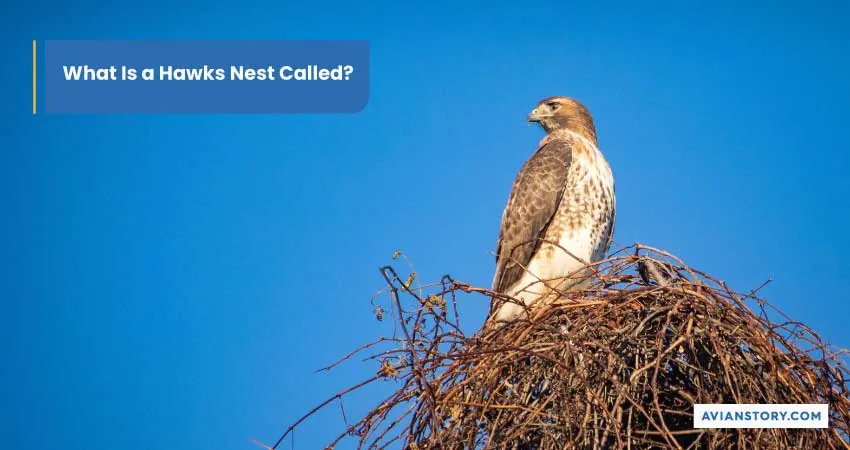
Hawks, like other birds of prey, do not have a distinct, globally recognized name for their nests. Hence the word “hawk nest” is often used to refer to the spot where hawks lay their eggs. Eyries and aeries are the more common terms.
The nesting grounds of eagles, falcons, and ospreys are all included under these umbrella words. Hawks and other birds of prey usually nest high up and out of the way, so the words “eyrie” and “aerie” are used to describe these places.
If the question arises, “Are Hawks Protected?” These nesting areas are chosen with great care to provide the bird security, concealment, and the ability to hunt and keep an eye out for predators. It’s important to keep in mind that various hawk species may have varying nesting site preferences.
Hawks may be seen nesting in a wide variety of locations, including-
- Trees
- Cliffs
- Rocky outcrops
- Buildings
- Transmission towers
Availability of suitable nesting sites, location, and the individual requirements of different hawk species may all play a role.
Do Hawks Build Nests?

Yes, hawks build nests. Hawks, which are members of the family Accipitridae, build nests in which they lay eggs and raise their young. Hawks’ nests are called eyries or aeries.
They spend a lot of time and energy building nests because they need a safe, elevated place to lay eggs and tend to their young as they hatch. Gathering and arranging sticks, twigs, and branches into a solid structure is a common part of the nest-building process.
Larger branches are used to build the structure of the nest, while smaller twigs and leaves are utilized to line the inside and protect the eggs and young from the elements.
Hawks’ nest-building activity is unique because it reflects their innate need to give their young the best possible start in life. This indicates not only their adaptability but also their use of man-made and natural structures as nesting sites.
Hawk Nest Size: How Big Is It?
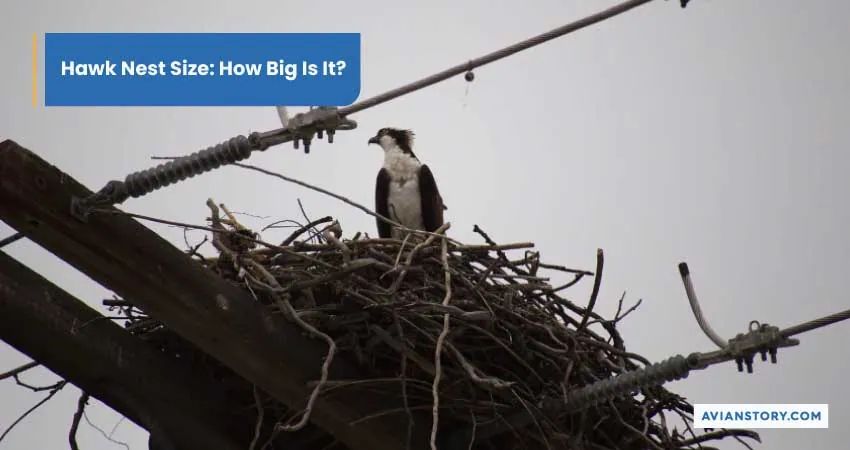
Depending on the species and the availability of nesting materials, a hawk’s nest may range in size. The nests of bigger hawk species are often larger than those of lesser hawk species.
Hawk nests typically have a diameter of between 2 and 4 feet (0.6 and 1.2 meters). However, some hawk nests may be significantly bigger, with a circumference of 5 or 6 feet (1.5 or 1.8 meters) or more.
Considering the Largest Hawk in the World (53 to 56 inch wingspan), one can imagine how large their normal nest size can be.
The hawks maintain and improve their nests with each new mating season. Because of this, the nests may grow to be very large, especially in species that rebuild their nests each year.
Smaller hawk species often construct nests that are just a few feet in diameter. Nests like this provide parents plenty of room to incubate eggs and raise young. However, bigger hawk species are capable of building nests that are several feet in diameter or more.
It’s worth noting that hawk nests often undergo renovation and expansion after each mating season, leading to an increase in size and complexity. This implies that older nests may grow to be fairly large when nesting materials are added year after year.
Where Do Hawks Nest?
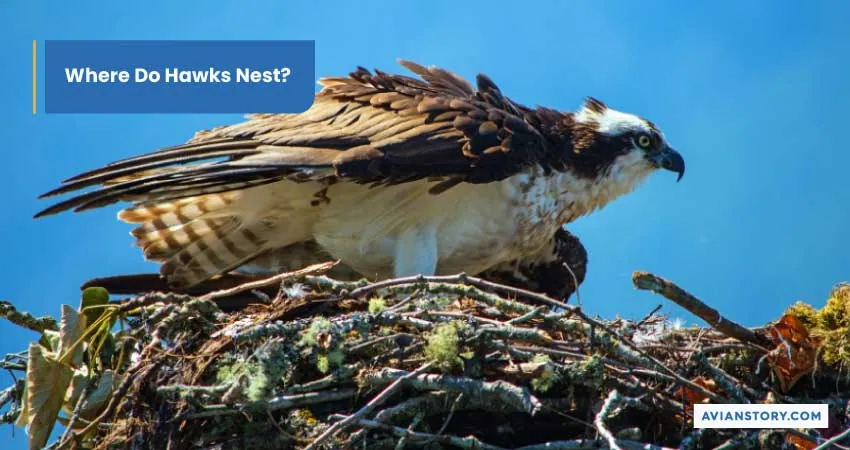
The species and environment determine where hawks nest. Hawks may nest in trees, cliffs, rocky ledges, or buildings. Hawks like lofty nests. Below are the places described where hawks nest in general.
Hawks Nest in Trees
Many hawk species nest in trees. They like large, strong trees with a good outlook. Hawks like trees with lush foliage or branches for nest hiding.
Cliffs and rocky ledges
Hawk’s nest on cliffs and ledges. Ground predators cannot reach these sites, providing protection. The rocky terrain allows for hunting and observation.
Man-Made constructions
Hawks may nest in urban constructions. They may nest on tall buildings, bridges, power towers, or other platforms. They like these lofty perches.
How Do Hawks Choose a Site/Place for Nesting?
- Elevated Location: Hawks like elevated places with a great view of their surroundings to monitor possible dangers and find prey.
- Safety and Protection: Hawks choose nesting areas that protect them from birds, animals, and people. Trees and cliffs provide more protection than ground-level places.
- Nest Stability: Hawks want solid, weatherproof nest places. This protects eggs and nestlings.
- Accessibility: Hawks pick nesting places that are easy to fly into and out of. They need room to approach the nest and land.
- Prey: Hawks nest near plentiful prey. This provides meals for parents and the young.
Hawks carefully choose a nesting spot to enhance their chances of reproducing and rearing their young. Watch this video to learn about Hawk Facts and their habitat.
When Is the Nesting Season for Hawks?
Hawks begin their annual nesting cycle in the spring, often in March or April. Hawks court, mate, and build their nests this season. It takes many weeks to care for the nestlings once they hatch from the eggs, which were incubated for several weeks.
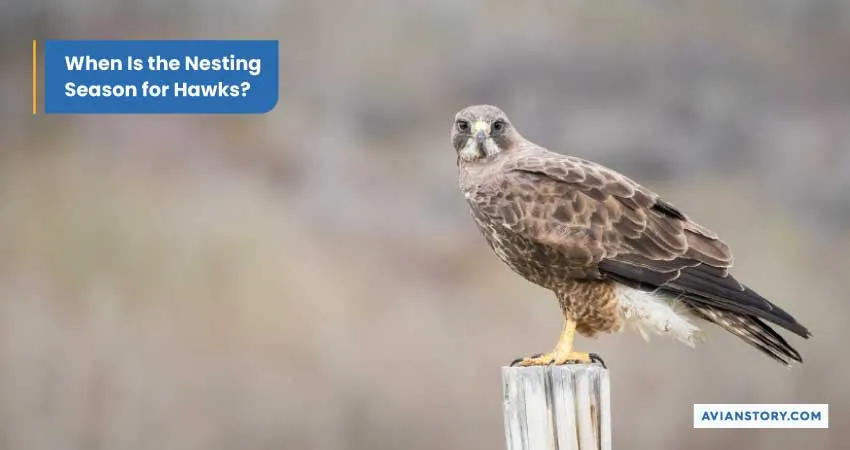
After the hawk breeding season is through, they may abandon the nest and not return until the following spring. Some hawk species are monogamous in their nesting habits, always returning to the same tree or ledge year after year.
Before the following mating season, they could add to and improve the nest. While many hawks return year after year to the same nesting location, some may choose to construct new nests or switch between nesting sites within their territory.
What Are the Mating and Egg-Laying Behaviors in Hawks During Nesting?
Hawks breed and deposit eggs during the nesting season. Their main behaviors at this time are as follows.
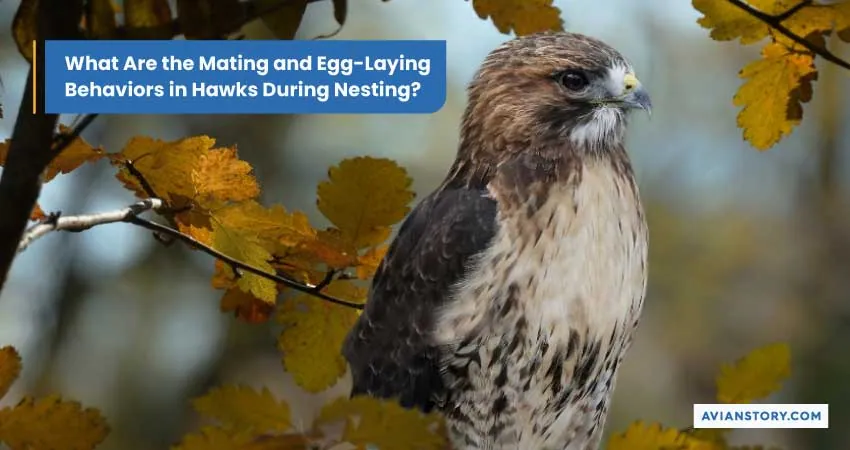
Courtship Displays
Hawks use elaborate displays to connect with possible mates. One might wonder, “Why Do Hawks Screech?” Screeching is part of their elaborate ritual, where males and females vocalize to communicate their readiness to mate and establish their bond. Aerial acrobatics and soaring flights are also done to help couples connect.
Pair Bonding
Hawks pair up after successful courting displays. The couple bonds via preening, nest site selection, and territorial defense. Successful breeding and upbringing depend on their link.
Nest Construction
Hawks build nests for egg-laying. Both hawk sexes make nests. They build a nest from sticks, twigs, branches, and other items. To keep warm, leaves, moss, and grass line the nest.
Egg-Laying
After building the nest, the female hawk lays eggs. Species lay one to many eggs. The female lays one egg every two or three days until the clutch is full. Hawk species lay white or pale eggs of various sizes.
Incubation starts when all eggs are deposited. The male hawk feeds and guards while the female incubates the eggs. Parents take turns incubating eggs for many weeks.
Hawks’ nesting cycle requires these actions. They help eggs grow, hatch, and feed young hawks until they leave the nest.
Are Hawks Endangered?
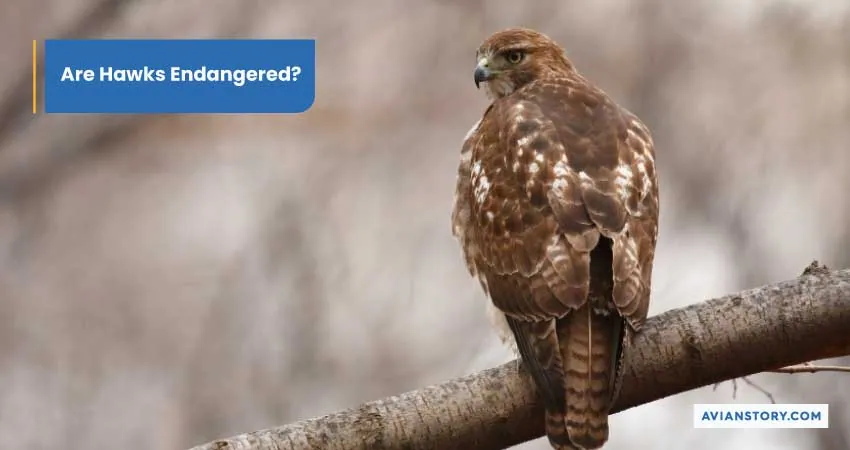
While hawks are not globally considered endangered, the conservation status of specific hawk species may vary. There are many types of Hawks, but the most endangered are Hawaiian Hawks.
Habitat loss, environmental changes, and other factors can impact hawk populations. Monitoring and protecting their habitats are crucial for the long-term survival of hawks.
To preserve the endangered species, it is required to attract them to ensure safe habitat. But How to Attract Hawks? The possible ways are discussed below-
- Creating suitable habitat features can increase the chances of attracting hawks.
- Tall trees, perches, and open spaces provide ideal hunting grounds for hawks.
- Offering a reliable food source, such as bird feeders or nest boxes, can also attract hawks.
Conclusion
It is essential for conservationists to learn about and safeguard hawks’ breeding habits. Hawks build their nests from branches and twigs high up in trees or on cliff faces. Courtship, nest building, egg laying, and incubation are all part of the springtime nesting ritual.
There are hawk species that exhibit nest site fidelity by always returning to the same nest. The survival of these magnificent birds of prey and their ecosystems may be aided by research into and protection of their nesting behaviors.
